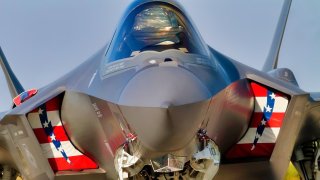Additive Printing to Help Keep USMC F-35s Flying
This is far from the first time that the U.S. military has embraced additive printing. Already, the services “print” parts and components that are no longer produced, and the U.S. Air Force is also employing it to keep the Northrop Grumman B-2 Spirit and Boeing B-52 Stratofortress bombers flying.
The Lockheed Martin F-35 Lightning II is a true marvel of the modern age, and soon maintainers will employ advanced technology to keep the aircraft flying—namely additive or “3D printing.” The United States Marine Corps announced that it has begun to “print” specialty tools used in the maintenance of the fifth-generation stealth fighter.
Early this summer, personnel with the Marine Aviation Logistics Squadron 13 found that there was a “critical shortage” of “reamers,” a precision cutting tool that is “essential to aviation maintenance” involving the F-35. The tools are used by ground crews to ensure “the proper fit and finish of composite materials and fasteners” on the Lightning II.
The problem was magnified due to the fact that the tools were costly to obtain, required a lengthy procurement time, and had a limited lifespan. At issue is that the reamers needed to be produced of Torlon, a type of high-performance thermoplastic that can be safely used on the costly stealth fighter, yet, it tends to wear out quickly.
3D Printing to the Rescue
Instead of waiting for the replacement reamers to be produced, Staff Sgt. Nicholas Bevan, an airframes technician, and Sgt. Landon Boroday, an aviation machinist, created their own customized reamer by employing additive printing. In addition to obtaining the essential tool lightning fast—down from three months to the very same day—the reamers produced by the two Marines could have a lifespan that is 300 percent longer than the traditionally produced versions, reducing the maintenance costs by nearly half.
Instead of Torlon, the airframe technician and aviation machinist used chopped carbon fiber strands and high-temperature resin that is more durable than the thermoplastic models.
“Torlon is a high strength, highly abrasive material that doesn’t damage the aircraft structure but is still abrasive enough to remove corrosion from the aircraft,” Bevan explained. “We have used carbon fiber as an alternative to Torlon, and as a 3D printing material, to make these reamers for the units in-house.”
The two Marines also tweaked the design slightly—employing Boroday’s experience with computer-aided design (CAD) as well as his knowledge of 3D printing. A pair of Markforged X7 industrial 3D printers was employed to print out the tools in a single day.
Major Cost Savings
The printers had already been used to produce other key components, including “corrosion treatment mandrels and radius blocks,” but this was the first time the specific tool was printed out.
According to the USMC, the efforts have already “saved MALS-13 more than $10,000 in its tool procurement costs,” while aircraft downtime across MAG-13 has also been reduced “by nearly 20% over a three-month period.”
“The versatility of these 3D printers is phenomenal,” said Boroday. “I got the information on which type of reamers the supply section was ordering, I did the math, and figured out it can cost less if we print them internally.”
The techniques could be further employed across the Marine Corps, and could even ensure that components could be manufactured in forward-deployed environments as needed. The service recognized that the two Marines overcame a challenge and adapted accordingly.
“Staff Sgt. Bevan and Sgt. Boroday’s initiative exemplifies the kind of forward-thinking innovation that directly enhances 3rd MAW’s readiness,” said Major General James Wellons, commanding officer of the 3rd MAW, who visited the MALS-13 and recognized the efforts of the two Marines—awarding them both the Navy and Marine Corps Achievement Medal.
“Their ability to develop solutions at the tactical level not only saves resources but keeps our aircraft mission-ready,” added Wellons. “This kind of ingenuity is what keeps 3rd MAW at the forefront of operational excellence.”
Embracing 3D Printing
This is far from the first time that the U.S. military has embraced additive printing. Already, the services “print” parts and components that are no longer produced, and the U.S. Air Force is also employing it to keep the Northrop Grumman B-2 Spirit and Boeing B-52 Stratofortress bombers flying.
The Marine Corps has previously used an HP Metal Jet 3D printer to produce components for its Assault Amphibious Vehicles (AAVs), which first entered service in 1972. More recently, the U.S. Navy and Marine Corps have used 3D printing to produce F-35 Full Mission Simulator (FMS) cockpits—an advanced high-fidelity flight simulator for the training of aviators on the Joint Strike Fighter.
The U.S. military may not quite be at the point where it can simply press Ctrl + P and see a jet fighter produced, or even many of the components, but 3D printing will help ensure the aircraft can keep flying while reducing the maintenance costs.
Author Experience and Expertise: Peter Suciu
Peter Suciu is a Michigan-based writer. He has contributed to more than four dozen magazines, newspapers, and websites with over 3,200 published pieces over a twenty-year career in journalism. He regularly writes about military hardware, firearms history, cybersecurity, politics, and international affairs. Peter is also aContributing Writer for Forbes and Clearance Jobs. You can follow him on Twitter:@PeterSuciu. You can email the author:[email protected].
Image Credit: Creative Commons and/or Shutterstock.

